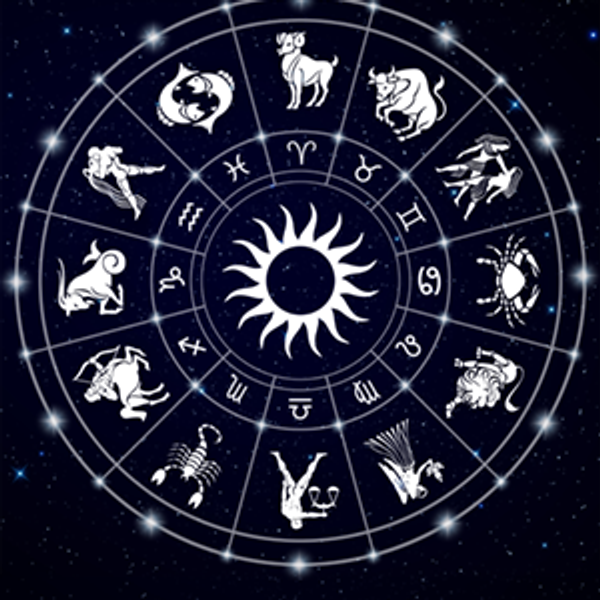Wasn’t it fun to learn about birth charts last time? You had a chance to see how the Houses look, so now you get to see what they’re about. We already went through how signs and planets operate, so now you’re ready to tackle the third part of astrology: houses!
Whereas a sign shows “how” something operates, and a planet shows “what” is operating, a house shows “where” the operation takes place. After learning about houses, you’ll know whether someone’s mind (Mercury) is usually focused on partnership (Seventh House), family (Fourth House), religion (Ninth House), etc. Or whether someone likes to date (Venus) intellectual types (Third House), ambitious types (Tenth House), or mysterious types (Eighth House). Whichever house a planet occupies sets the focus of that planet, regardless of which sign that planet occupies (the attributes the planet owns). Houses bring structure to the planets and signs inside them.
The following are features of the twelve houses: natural signs, ruling planets, groupings, sections, and intercepted and duplicated signs.
Natural Signs and Ruling Planets
Each house is correlated with a sign based on the sign’s place in the Zodiac. So the First House is associated with Aries, the Second House with Taurus, and so on. The ruling planet of each house is the ruling planet of its natural sign: the First House is ruled by Mars (Aries’s ruling planet), the Second House by Venus (Taurus’s ruling planet), and so on.
Here’s the confusing part. Although each house is correlated with a specific sign and planet, any sign and any planet can be in any house. Having the correlations just makes it easier to see how a given sign or planet will operate in a house. So Mars would be strongest in the First House, and weakest in the Seventh House, while Venus would be strongest in the Second and Seventh Houses, and weakest in the Eighth and First Houses. The more understanding you have of the signs and planets, the better acquainted you’ll feel with their house placements as you learn about them. There will be more about each house’s natural sign and ruling planet in the coming articles.
Groupings of Houses
Each house is associated with a specific area of life. However, the houses are placed into two groupings based on the classifications of their natural signs.
One grouping is based on the elements of the signs and divides the houses into four three-house groups:
Fire (Spirit): The First, Fifth, and Ninth Houses are what I call Spirit Houses. They focus on motivation, the big picture, getting a move on, and grabbing life by the reins. People with many planets in these houses have that fiery burn about them and have no problem getting things done. Their weak spot is their tendency to push focus to the side in favor of the thrill.
Earth (Substance): The Second, Sixth, and Tenth Houses are Substance Houses. They’re about the physical and practical parts of life. Substance Houses are related to financial security and tangible results. When a person has many planets in Substance Houses, (s)he tends to be more realistic, grounded, and responsible. However, the person can be too involved in the mundane and be a victim of “all work and no play.”
Air (Social): The Third, Seventh, and Eleventh Houses are Social Houses. Social Houses deal with relationships and communication. These are the houses where you socialize with those outside of your immediate household and learn as much from others as they learn from you. If someone has the majority of their planets in Social Houses, (s)he is more intellect-oriented and enjoys interacting with other people. Unfortunately, (s)he is also inclined to rely too much on their social life and can have a hard time with solitude.
Water (Secret): The Fourth, Eighth, and Twelfth Houses are Secret Houses. Each one revolves around things that are unnoticeable on a conscious level or kept private from others. Having many planets in Secret Houses can give people vivid imaginations and the ability to feel others’ emotions deeply with little effort. On the other hand, people with a Secret House emphasis may be overemotional, keep too much to themselves, and suffer from bouts of depression.
An important thing to keep in mind is that other factors can counteract heavy emphasis on a house's element. For example, if you have many planets in water houses, but they’re also in air signs, the gregarious and logical nature of air will balance out the emotional nature of water. Or, if you have a lot of planets in air houses, but most of them are in the lower half of the chart (see Sections of Houses), you could be an extrovert who prefers sticking to those you already know well: an ambivert.
The other grouping is based on the qualities of the signs and divides the houses into three four-house groups:
Cardinal (Angular): The First, Fourth, Seventh, and Tenth Houses are the Angular Houses, named so because their cusps lie on the “angles,” or bold lines of the chart. They represent beginnings in life, or parts of life, that take place through a starting event, like birth or a wedding. Having the majority of your planets in Angular Houses will give people very cardinal personalities: charging ahead, starting things immediately, seizing opportunities in a snap. They’ll be excellent when it comes to getting things going. Finishing them… yeah, about that…
Fixed (Succedent): The Second, Fifth, Eighth, and Eleventh Houses are the Succedent Houses. These houses revolve around matters that don’t necessarily have a set start or beginning but usually stay (or should stay) consistent throughout most of one’s life. Having the majority of planets in Succedent Houses will give people fixed personalities: stable, consistent, not flying all over the place. They can become a little too rigid or stubborn, however.
Mutable (Cadent): The Third, Sixth, Ninth, and Twelfth Houses are the Cadent Houses. Cadent Houses represent parts of life that may change constantly, forcing people to adjust over and over again. Having most of their planets in Cadent Houses shows that they’re adaptable, easygoing, and open. They may also have trouble grounding themselves and keeping focus.
Sections of Houses
Houses are also divided into hemispheres and quadrants. Having many planets in a given hemisphere and/or quadrant can show a lot about the chart holder’s general personality.
Hemispheres
Bottom Hemisphere: Houses 1-6. Emphasis on the bottom hemisphere in natal charts tends to result in introversion. These chart holders prefer to be in the company of an intimate few, or those they know well, over being in large groups and around strangers. They keep out of the public eye and dislike having all the attention placed on them. They like one-person activities, such as reading, and enjoy peace and quiet. Bottom hemisphere emphasis can be balanced out by having many planets in fire and air signs, as well as Spirit and Social Houses.
Top Hemisphere: Houses 7-12. Emphasis on the top hemisphere in natal charts tends to result in extraversion. These chart holders prefer to be in large groups and loud gatherings, rather than being in the comforts of their own home or bedroom. They enjoy being out in public and being seen and have no problem socializing. Going out to parties outings and taking long-distance trips bring grins to their faces. Top hemisphere emphasis can be balanced out by having many planets in earth and water signs, as well as Substance and Secret Houses.
Left Hemisphere: The left hemisphere covers Houses 1-3 and 10-12. When people have most of their planets in the left hemisphere, they take destiny into their own hands. They handle all their problems and tasks by themselves. Typically, whatever happens to them—positive or otherwise—is the result of their own doing. They’re not open to asking others for help, or allowing others to help them. Lucky breaks usually come from something they do, or have already done in the past.
Right Hemisphere: The right hemisphere covers Houses 4 through 9. When people have most of their planets in the right hemisphere, they achieve results through their relationships with others. They’re team players rather than individual workers. The events in their lives happen as a result of help from others. That’s not to say that they never do any of their own work. They just get more of their lucky breaks indirectly: for example, family members connecting them to potential employers, or friends letting them marry in their backyards to cut venue costs.
Quadrants
Quadrant I: The bottom hemisphere blends with the left hemisphere. This is as solitary as solitary gets. Having many planets in Houses 1-3 results in a loner disposition unless there are conflicting factors present. Extremely self-reliant. They keep to a few trusted individuals and think for themselves.
Quadrant II: The bottom hemisphere blends with the right hemisphere (Houses 4-6). Definite ambiverts: they love to socialize, but only to those with whom they are close. They’re good at doing behind-the-scenes work that involves being part of a team (i.e. stage sets, make-up artistry, costume design, etc.). They may feel a need to have friends, but their shyness poses a problem in that regard.
Quadrant III: The top hemisphere meets the right hemisphere (Houses 7-9). This is the most outgoing and social of the four quadrants. Great team players who know how to do their parts. They’re sociable, friendly, and fun. They may have to learn how to unwind away from the world in order to achieve equilibrium.
Quadrant IV: The top hemisphere meets the left hemisphere (Houses 10-12). People with many planets in this quadrant make great team leaders. Dynamic and self-willed, they get things done for the community. Their downside lies in carrying too much for the group, whether it’s a classroom, an organization, or a country.
Intercepted and Duplicated Signs
Placidus charts nearly always have unequal houses. Some houses will span twenty-five degrees in a chart, for example; some will span thirty-five.1 This means that, in many cases, a house may start in one sign, encompass the entirety of the next sign, and end in the sign after that. For instance, in my own chart, my Fifth House begins in Libra, takes in all of Scorpio, and ends in Sagittarius, where my Sixth House begins. This means Scorpio is intercepted in my chart. In addition, every house is equal in span to its opposite house; not only is Scorpio intercepted in my natal chart but so is Taurus. This means that the traits of Taurus and Scorpio are kind of locked away from me, and I have to do some work to unlock them, as well as any planets that may be in those signs (I have Jupiter and Pluto in Scorpio; nothing in Taurus).
“How do I unlock these intercepted signs and planets if I have them?” you may ask. Not to worry, my friend. There are many ways to unlock intercepted signs and planets. For one, you can look to the houses in which they are locked. So I’d have to utilize my Fifth House and Eleventh House energies. Got it. Second, and this is key, for every set of opposite signs that is intercepted, there is a set of duplicated opposite signs; they land on two house cusps instead of one. In my chart, Taurus and Scorpio are intercepted—they don’t land on a house cusp. So Leo lands on both my Second House and Third House cusps, putting Aquarius on my Eighth House and Ninth House cusps. The traits of duplicated signs can also help you enter your intercepted signs. I would have to practice Leo and Aquarius traits in order to unlock Taurus and Scorpio ones. The Houses on duplicated signs can also help unlock interceptions. There are so many ways to do it! There is another method, involving the rulers of the intercepted signs, but it’s too early to go into it right now.
I hope this article helped you to understand houses, just a little bit. Piece by piece, you’ll learn how to read your own chart and see what it reveals about you. Next week, we’re going to go over one of the utmost important parts of your chart—as important as the Sun and Moon.
Next Article: “The First House: How You Appear”
1Equal houses would result in 12 houses, each of which is 30 degrees—a perfect circle.













 man running in forestPhoto by
man running in forestPhoto by 










